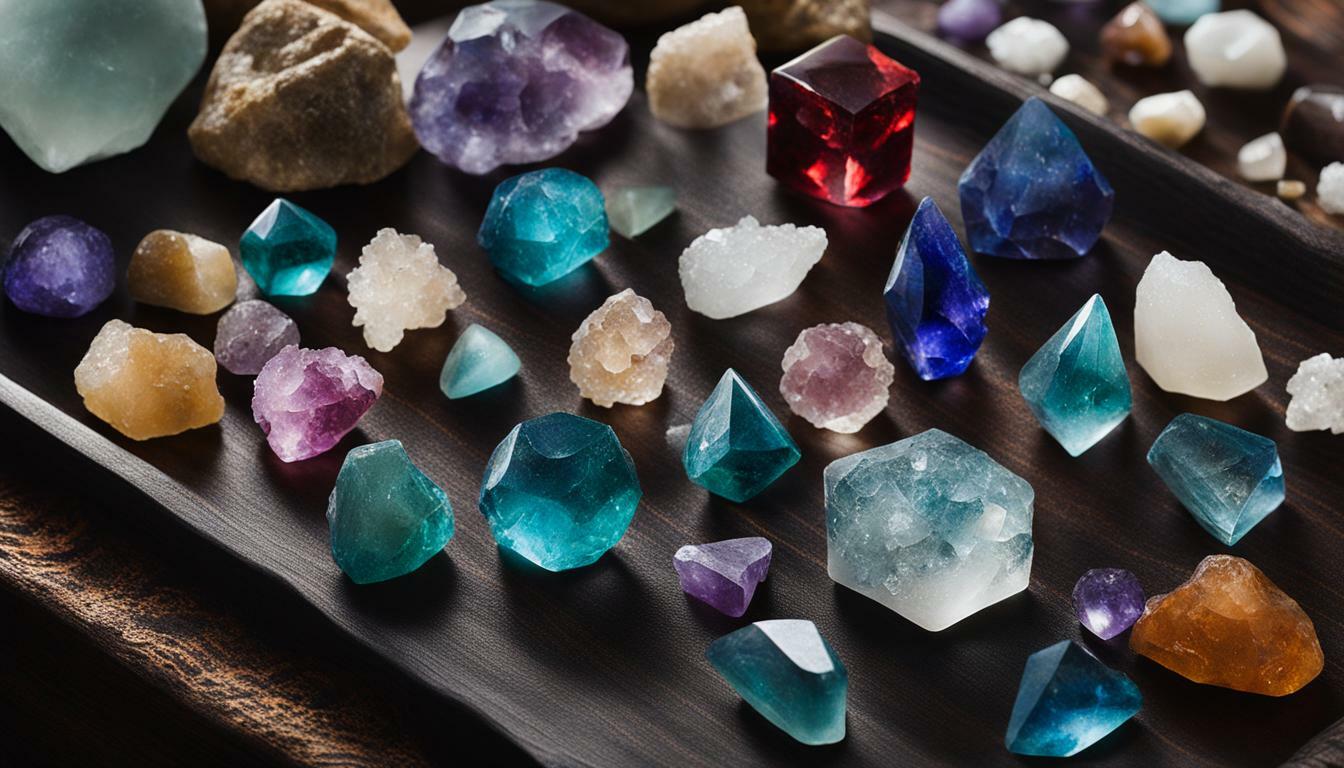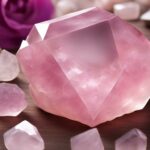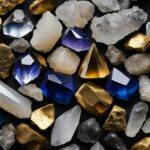Are you wondering which crystals in your collection can safely be used with water? It’s essential to understand the characteristics and composition of crystals to ensure their longevity and safety when exposed to water. Factors such as the Mohs hardness scale, iron content, and other potentially toxic minerals present in the crystal play a crucial role in determining their compatibility with water. While crystals with a Mohs hardness of 6 or higher are generally considered safe for water use, it’s important to research each crystal individually to avoid any exceptions. This article will provide you with valuable insights into water-safe crystals and guide you in making informed decisions about your crystal collection.
Key Takeaways:
- Consider the Mohs hardness scale, mineral content, and toxicity when determining if a crystal is water safe.
- Crystals ending in “ite,” such as Malachite, Calcite, Hematite, Fluorite, and Selenite, are generally not safe for water use due to their low water tolerance and softer nature on the Mohs scale.
- Crystals like Amethyst, Black Obsidian, Carnelian, Citrine, Clear Quartz, Rose Quartz, Rutilated Quartz, and Smoky Quartz are generally safe for water use.
- Avoid crystals with toxic elements or harmful chemicals, such as copper, lead, sulfur, asbestos, or others.
- Properly cleanse crystals using methods other than water for softer crystals, such as using the light of a full moon or smudging.
- Some crystals should not be cleansed with salt water, while others, such as Clear Quartz, Smoky Quartz, Rutilated Quartz, Rose Quartz, Amethyst, Citrine, Agate, Jasper, Moonstone, and Aventurine, can be safely cleansed in salt water.
- Research the individual composition and characteristics of each crystal before exposing them to water or salt water.
Factors to Consider for Water-Safe Crystals
To determine if a crystal is water safe, there are several factors you should take into account, including its hardness on the Mohs scale, presence of potentially toxic minerals, and susceptibility to damage. Crystals with a higher Mohs hardness scale are generally more resistant to water and less likely to be damaged. However, it’s important to research each crystal individually, as there can be exceptions to this rule.
One important consideration is the presence of potentially toxic minerals in the crystal. Some crystals may contain elements like copper, lead, sulfur, asbestos, or other harmful chemicals, making them unsuitable for water use. It’s crucial to avoid these crystals to ensure your safety and well-being.
Another factor to consider is the susceptibility of the crystal to damage when exposed to water. Crystals with a low water tolerance and those that are softer on the Mohs scale are more likely to be damaged or dissolve in water. For example, crystals ending in “ite” such as Malachite, Calcite, Hematite, Fluorite, and Selenite are generally not water safe.
To help you understand the compatibility of different crystals with water, here’s a summary:
| Crystal | Water Safe |
|---|---|
| Amethyst | Yes |
| Black Obsidian | Yes |
| Carnelian | Yes |
| Citrine | Yes |
| Clear Quartz | Yes |
| Rose Quartz | Yes |
| Rutilated Quartz | Yes |
| Smoky Quartz | Yes |
Remember, it’s essential to check the individual composition and characteristics of each crystal before putting them in water. By doing proper research and being intentional and conscious about crystal care, you can maintain a safe and effective water cleansing routine for your crystal collection.
Crystals Not Safe for Water Use
While some crystals can thrive in water, there are several popular varieties that you should avoid immersing or exposing to water due to their low water tolerance and potential for damage. These crystals include Malachite, Calcite, Hematite, Fluorite, and Selenite. These crystals have a low water tolerance and are softer on the Mohs scale, making them susceptible to damage.
Malachite, for example, is a beautiful green crystal that should be kept away from water. Its low water tolerance can cause it to become discolored or even disintegrate. Calcite, with its delicate nature, is another crystal that should not be exposed to water. Water can dissolve the crystal, leading to irreversible damage. Hematite, despite its metallic appearance, is also not water-safe. Water can cause the iron content in Hematite to rust, tarnishing its surface.
Fluorite, known for its vibrant colors and transparency, should also be kept dry. Water can erode Fluorite, compromising its structure and appearance. Lastly, Selenite, with its softness and delicate nature, should be kept away from water. Immersion in water can cause Selenite to dissolve, resulting in a loss of its unique beauty.
It’s essential to be aware of these crystals’ low water tolerance and take precautions to ensure their longevity. Always research and assess the individual characteristics of each crystal before exposing them to water. By doing so, you can maintain the integrity and beauty of your crystal collection.
Crystals Safe for Water Use
If you’re looking to incorporate crystals in your water rituals, there are numerous options that are considered safe for water use, such as Amethyst, Black Obsidian, Carnelian, Citrine, Clear Quartz, Rose Quartz, Rutilated Quartz, and Smoky Quartz. These crystals not only add beauty to your water but also offer unique healing properties that can enhance your overall well-being.
Amethyst, known for its calming and protective energy, is often used to promote relaxation and spiritual growth. Black Obsidian, on the other hand, is a powerful stone for grounding and protection, helping to absorb negative energy and purify your water. Carnelian, with its vibrant orange hue, energizes and motivates, making it an excellent crystal for boosting creativity and vitality.
Citrine, often referred to as the “stone of abundance,” is believed to bring wealth, success, and positivity. Clear Quartz, a versatile and widely available crystal, is known for its amplifying properties, enhancing the energy of other crystals and promoting clarity and balance. Rose Quartz, the stone of love, supports compassion, self-love, and emotional healing.
Rutilated Quartz, with its golden threads running through it, is believed to bring strength and promote spiritual growth. Lastly, Smoky Quartz, a grounding and protective crystal, helps to transmute negative energy and promote a sense of stability and emotional well-being.
Salt Water Cleansing
When it comes to cleansing your crystals, salt water is a commonly used method. However, it’s important to note that not all crystals are suitable for this type of cleansing. Crystals like Fluorite, Malachite, Tangerine Quartz, Amber, and Lapis Lazuli should be avoided when using salt water, as it can cause them to dissolve or weaken.
On the other hand, Clear Quartz, Smoky Quartz, Rutilated Quartz, Rose Quartz, Amethyst, Citrine, Agate, Jasper, Moonstone, and Aventurine can be safely cleansed in salt water. To cleanse your crystals, simply create a solution of salt water by dissolving sea salt or Himalayan salt in distilled water. Place your crystals in the solution and leave them for a few hours or overnight to remove any negative energy.
| Crystals Safe for Salt Water Cleansing |
|---|
| Clear Quartz |
| Smoky Quartz |
| Rutilated Quartz |
| Rose Quartz |
| Amethyst |
| Citrine |
| Agate |
| Jasper |
| Moonstone |
| Aventurine |
Remember to always check the individual composition and characteristics of each crystal before using it in water or salt water, as some crystals may have specific care requirements or may not be suitable for water use. By taking the time to research and understand the properties of your crystals, you can ensure a safe and effective water cleansing routine for your crystal collection.
Caring for Water-Safe Crystals
Taking care of your water-safe crystals is crucial to maintain their energy and longevity, and it’s important to understand the appropriate cleansing methods to ensure their effectiveness. While water can be a powerful tool for purifying and cleansing certain crystals, it’s vital to remember that not all crystals can withstand exposure to water.
For softer crystals that are not water safe, alternatives to water cleansing methods should be used. The light of a full moon is a gentle and effective way to cleanse these crystals, allowing them to recharge in the moon’s energy. Alternatively, you can use the practice of smudging, which involves passing the crystal through sacred smoke from herbs such as sage or palo santo.
When it comes to salt water cleansing, it’s important to exercise caution as not all crystals are compatible with this method. Crystals such as Fluorite, Malachite, Tangerine Quartz, Amber, and Lapis Lazuli should be avoided, as salt water can cause them to dissolve or become weaker. However, crystals like Clear Quartz, Smoky Quartz, Rutilated Quartz, Rose Quartz, Amethyst, Citrine, Agate, Jasper, Moonstone, and Aventurine can be safely cleansed in salt water.
Remember, each crystal is unique, and it’s essential to check its individual composition and characteristics before exposing it to water or salt water. Proper research and understanding of your crystals will ensure that you maintain a safe and effective water cleansing routine for your crystal collection, allowing their energy to thrive and your connection to them to deepen.
Can Amethyst Crystals Be Safely Used in Water Collections?
Amethyst crystals are prized for their striking violet hue and powerful healing properties. However, not all crystals that complement amethyst are safe to use in water collections. While amethyst itself is generally safe, certain crystals, such as selenite or pyrite, can be damaged or dissolve when immersed in water. It’s essential to research each crystal’s unique properties before adding them to your water collection to maintain their integrity and ensure safety.
FAQ
What factors should I consider when determining if a crystal is safe to use with water?
Factors to consider include the Mohs hardness scale, presence of potentially toxic minerals, and susceptibility to damage. Generally, crystals with a Mohs hardness of 6 or higher are considered safe for water use, but it’s important to research each crystal individually.
Which crystals are not safe for water use?
Crystals such as Malachite, Calcite, Hematite, Fluorite, and Selenite are not water-safe. These crystals have a low water tolerance and are softer on the Mohs scale, making them susceptible to damage.
Which crystals are generally considered safe for water use?
Crystals like Amethyst, Black Obsidian, Carnelian, Citrine, Clear Quartz, Rose Quartz, Rutilated Quartz, and Smoky Quartz are generally considered safe for water use. These crystals are compatible with water, durable, and suitable for water healing or purification practices.
How should I care for water-safe crystals?
It’s important to cleanse softer crystals without using water. Instead, consider using the light of a full moon or smudging. Additionally, avoid exposing water-safe crystals to salt water, as it can cause certain crystals to dissolve or become weaker.
Which crystals can be safely cleansed in salt water?
Crystals such as Clear Quartz, Smoky Quartz, Rutilated Quartz, Rose Quartz, Amethyst, Citrine, Agate, Jasper, Moonstone, and Aventurine can be safely cleansed in salt water. However, it’s essential to check the individual composition and characteristics of each crystal before using salt water for cleansing.








